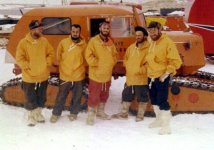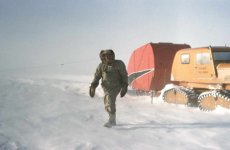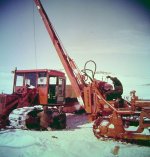akmountaineer
New member
Not sure if this has been here before, but I found it amusing...
Antarctic Explorer
Words by Ian White.

The snow whips around the flagpole, atop the central hut of the minute settlement, itself clinging to the edge of the driest continent on Earth. The year is 1965, and the huts mark the location of the Wilkes Antarctic Base.
The last of the vehicles rounds the edge of the camp, snow and i ce flyi ng in the wake of the tracks on the vehicle. It stops and the swirling snow settles briefly, as the driver leaps out and heads to the shelter of the hut, the clearing snow revealing for a moment the familiar shape of a Mini.
This scenario isn’t as fanciful as you might think, as a highly-modifi ed Mini was used at the Wilkes Antarctic Station in 1965.
While most people would expect specialpurpose snowmobiles to be used in such locations, few people would be aware that a specially modifi ed Mini was one such vehicle used by Australians in the Antarctic.
Australia has a long history of scientific research in Antarctica, currently with three permanent bases on the Antarctic continent, Macquarie Island.
A fi fth base, Wilkes, had operated previously, the International Geophysical Year (IGY) programme, on the western end of the Clark Peninsula, and handed over to Australia in 1959 after the conclusion of IGY.
By 1964 it was found that Wilkes would soon be uninhabitable, due to snow and ice build-up that threatened the integrity of the buildings, so work began on a Replacement Station (Repstat), now known as Casey, about 2km away, on the Bailey Peninsula. Wilkes was abandoned, with the completion of Casey, in 1969.
Australia’s Antarctic bases are operated by the Australian National Antarctic Research Expeditions (ANARE), which was established in 1947. The Australian Antarctic Division (AAD) of the Department of External Affairs was created in May 1948, to give the ANARE a permanent footing.

In 1960 ANARE decided that modified small, cheaper, vehicles should be trialed in addition to the larger, more complex, tracked vehicles that were then being used. In 1962 Volkswagen Australia provided a suitable VW Beetle (imaginatively named and registered as “Antarctic 1”), and another in 1963 (“Antarctic 2“).
While these performed fairly well in the conditions, they were still only two-wheeldrive and were limited in the type of terrain they could cross. Several conventional motorbikes were also trialed, with varied success, but they were unable to carry much, if any, equipment.
At this time Terry O’Hare operated a motor body building business under the name Recar (as it was a reincarnation of a previous business) in the western Melbourne suburb of Sunshine. Terry started Recar in 1956, building timber bodies on the rear of local cars (like the American “woodies” that were popular at the time).
First version had shorter tracks.
However, Recar is probably best remembered for the jet truck “Waltzing Matilda”, powered by an Avon Mk 1 jet engine from a Canberra bomber. Built by Terry and his son Stephen in 1978, Waltzing Matilda was the world’s fi rst jet-powered truck – later going on to break the world truck speed record.

Back in the 1960s, though, Recar imported Porsche-powered Snow-Trac chassis from Sweden, and the heavier Nodwell tracked truck chassis from Canada, and then built bodies on them to ANARE’s requirements. A Nodwell (“Miss-Take”) is pictured in the photos of one of the Mini-tracs in Antarctica, while a Snow-trac is visible in the photo of the truck loaded with a Mini-trac for the Brimbank Festival procession in Sunshine.
Terry realised that a smaller tracked vehicle would be ideal for use by ANARE and set about designing and building one. He had decided that the base vehicle should be front wheel drive, as many snow vehicles have the drive wheel at the front of the tracks, and be relatively cheap to buy.
The only locally available options really were the just released Morris 1100, and the more established Morris 850 - which was chosen. Terry’s idea was to use as much of the original Mini as possible, so the drive for the tracks came directly from the Mini’s power unit.
Following the lead of the Snow-Trac, Terry named his new creation the Mini-Trac.
In the fi rst version, shown in a newspaper clipping, the driveshafts, universal joints, hubs and suspension were removed, and drive sprockets fitted to the differential output shafts – which provided power to the track drive sprockets via chains. The track drive sprockets were mounted onto the chassis, directly under each differential output shaft, and provided independent drive to each track.
On the subsequent versions of the Mini-Trac an idler shaft was placed directly below the differential output shafts and a second chain taken forward to extend the track length, which also gave better balance by reducing the problem of the engine’s weight overhanging the front of the tracks.
The tracks themselves were taken from the Snow-Trac ST-4. These were made from a four-ply ” 9.5mm thick conveyor-belt type rubber matting, and each track consisted of two belts, each 180mm wide.
The two belts were spaced around 75mm apart and joined together by steel “grousers” (steel strips which provide traction on the snow) bolted through the belts, and which also served as the links for the drive sprocket. On top of the grousers (on the inside of the tracks when fi tted), and sharing the bolts, were steel wheel guides that kept the tracks running on the three Mini wheels fi tted to each side of the vehicle.
http://bmcexperience.com.au/issue-17/mini-trac.html
Antarctic Explorer
Words by Ian White.

The snow whips around the flagpole, atop the central hut of the minute settlement, itself clinging to the edge of the driest continent on Earth. The year is 1965, and the huts mark the location of the Wilkes Antarctic Base.
The last of the vehicles rounds the edge of the camp, snow and i ce flyi ng in the wake of the tracks on the vehicle. It stops and the swirling snow settles briefly, as the driver leaps out and heads to the shelter of the hut, the clearing snow revealing for a moment the familiar shape of a Mini.
This scenario isn’t as fanciful as you might think, as a highly-modifi ed Mini was used at the Wilkes Antarctic Station in 1965.
While most people would expect specialpurpose snowmobiles to be used in such locations, few people would be aware that a specially modifi ed Mini was one such vehicle used by Australians in the Antarctic.
Australia has a long history of scientific research in Antarctica, currently with three permanent bases on the Antarctic continent, Macquarie Island.
A fi fth base, Wilkes, had operated previously, the International Geophysical Year (IGY) programme, on the western end of the Clark Peninsula, and handed over to Australia in 1959 after the conclusion of IGY.
By 1964 it was found that Wilkes would soon be uninhabitable, due to snow and ice build-up that threatened the integrity of the buildings, so work began on a Replacement Station (Repstat), now known as Casey, about 2km away, on the Bailey Peninsula. Wilkes was abandoned, with the completion of Casey, in 1969.
Australia’s Antarctic bases are operated by the Australian National Antarctic Research Expeditions (ANARE), which was established in 1947. The Australian Antarctic Division (AAD) of the Department of External Affairs was created in May 1948, to give the ANARE a permanent footing.

In 1960 ANARE decided that modified small, cheaper, vehicles should be trialed in addition to the larger, more complex, tracked vehicles that were then being used. In 1962 Volkswagen Australia provided a suitable VW Beetle (imaginatively named and registered as “Antarctic 1”), and another in 1963 (“Antarctic 2“).
While these performed fairly well in the conditions, they were still only two-wheeldrive and were limited in the type of terrain they could cross. Several conventional motorbikes were also trialed, with varied success, but they were unable to carry much, if any, equipment.
At this time Terry O’Hare operated a motor body building business under the name Recar (as it was a reincarnation of a previous business) in the western Melbourne suburb of Sunshine. Terry started Recar in 1956, building timber bodies on the rear of local cars (like the American “woodies” that were popular at the time).
First version had shorter tracks.
However, Recar is probably best remembered for the jet truck “Waltzing Matilda”, powered by an Avon Mk 1 jet engine from a Canberra bomber. Built by Terry and his son Stephen in 1978, Waltzing Matilda was the world’s fi rst jet-powered truck – later going on to break the world truck speed record.

Back in the 1960s, though, Recar imported Porsche-powered Snow-Trac chassis from Sweden, and the heavier Nodwell tracked truck chassis from Canada, and then built bodies on them to ANARE’s requirements. A Nodwell (“Miss-Take”) is pictured in the photos of one of the Mini-tracs in Antarctica, while a Snow-trac is visible in the photo of the truck loaded with a Mini-trac for the Brimbank Festival procession in Sunshine.
Terry realised that a smaller tracked vehicle would be ideal for use by ANARE and set about designing and building one. He had decided that the base vehicle should be front wheel drive, as many snow vehicles have the drive wheel at the front of the tracks, and be relatively cheap to buy.
The only locally available options really were the just released Morris 1100, and the more established Morris 850 - which was chosen. Terry’s idea was to use as much of the original Mini as possible, so the drive for the tracks came directly from the Mini’s power unit.
Following the lead of the Snow-Trac, Terry named his new creation the Mini-Trac.
In the fi rst version, shown in a newspaper clipping, the driveshafts, universal joints, hubs and suspension were removed, and drive sprockets fitted to the differential output shafts – which provided power to the track drive sprockets via chains. The track drive sprockets were mounted onto the chassis, directly under each differential output shaft, and provided independent drive to each track.
On the subsequent versions of the Mini-Trac an idler shaft was placed directly below the differential output shafts and a second chain taken forward to extend the track length, which also gave better balance by reducing the problem of the engine’s weight overhanging the front of the tracks.
The tracks themselves were taken from the Snow-Trac ST-4. These were made from a four-ply ” 9.5mm thick conveyor-belt type rubber matting, and each track consisted of two belts, each 180mm wide.
The two belts were spaced around 75mm apart and joined together by steel “grousers” (steel strips which provide traction on the snow) bolted through the belts, and which also served as the links for the drive sprocket. On top of the grousers (on the inside of the tracks when fi tted), and sharing the bolts, were steel wheel guides that kept the tracks running on the three Mini wheels fi tted to each side of the vehicle.
http://bmcexperience.com.au/issue-17/mini-trac.html




